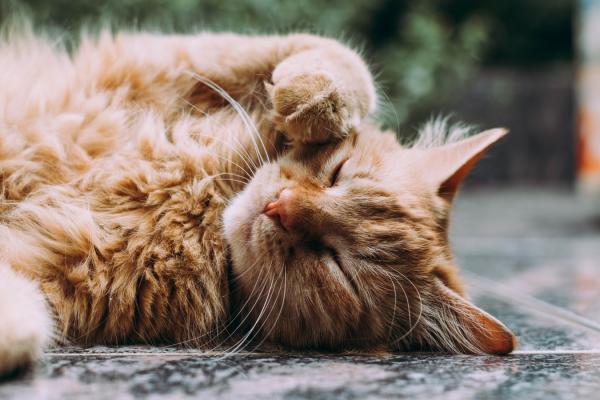
Have you noticed your cat losing balance back legs or that your cat is suddenly walking like it’s drunk? If so, your cat may be suffering from ataxia. Ataxia in cats, otherwise referred to as a loss of balance in cats, is a health problem more common in domestic cats. Treatment for ataxia in cats requires veterinary attention.
For more about the causes, symptoms and treatment of ataxia in cats, keep reading here at AnimalWised.
Ataxia in cats
Have you ever seen a kitten with a peculiar gait, both somewhat uncoordinated and wobbly? This sudden loss of balance in cats is known as ataxia, which is defined as a lack of coordination and movement precision in an animal.
Ataxia in cats mainly affects a cat’s sense of movement and balance, its body position (especially among the extremities), and a cat’s level of stability. Is your cat stumbling and disoriented? Some cats suffering from ataxia will often take smaller steps and appear as if they are jumping rather than walking, this is a case known as hypometria. If your cat is, however, taking longer steps which seem dragged, it is referred to as hypermetria.
Ataxia is a condition which occurs when there is a problem or an injury in an area of the body that controls movement. In fact, ataxia is considered to be a symptom rather than a disease in itself. These main areas of an animal’s body which are responsible for movements include:
- The proprioception or sensory system is found in the peripheral nerves and in the spinal cord. These help an animal detect the position or movement of its muscles, tendons and joints. Therefore, a problem or injury in this system can cause the loss of position and movement control.
- The vestibular system serves to help an animal maintain balance and posture. This is in addition to regulating eye, tail and limb positioning and maintaining a sense of balance and orientation. Problems that occur in the middle-inner ear, in the vestibular nerve and in the brainstem can cause a cat to suffer from vestibular syndrome. One of the main signs of vestibular syndrome in cats is head tilting. For more, we suggest taking a look at our article where we discuss everything you need to know about vestibular disease in cats.
- The cerebellum has several functions that affect the coordination and precision of movements. First, it receives information from the sensory system, the vestibular system and the visual and auditory systems. Then, the cerebellum processes this information and compares it with the desired movement thereby ordering the muscles to move. The cerebellum, in simple, helps coordinate the muscles.
Some cats are born with this condition, while others suffer a fall or accident which can cause its onset. If you believe that your cat is suffering from ataxia, we recommend consulting a veterinarian. The sooner the correct diagnosis is made, the faster treatment can occur. Recovery rate will always depend on the severity of the ataxia.

Ataxia in cats: causes
The most common causes of ataxia in cats include:
- A lesion in one of the three aforementioned systems (vestibular, sensory and cerebellum), such as cerebellar hypoplasia cat.
- Nervous system conditions.
- Extreme weakness caused by other problems such as starvation, anemia, etc.
- Muscle problems.
- Problems in systems which can affect brain function and peripheral nerves, such as cat stroke.
- Orthopedic conditions that affect bones and joints and/or manx syndrome.
Some of these problems and injuries can be caused by accidents, poisoning, diet problems, tumors and serious infections, among other possibilities.

Ataxia in cats: types
Ataxia in cats can be divided into three different types, depending on the area which is affected:
- Cerebellar ataxia: affects the cerebellum, weakening its control over balance and coordination of movements. Felines that suffer from this type of ataxia can stand, but will suffer from an uncoordinated and exaggerated walk. They will also walk with their legs separated, bouncing and trembling. They may also experience difficulty jumping. If they do jump, it will appear exaggerated and clumsy.
- Vestibular Ataxia: is caused by an middle-inner ear problem or brain and ear nerve problem. This problem is often unilateral, visible on the side by which a cat tilts its head. A cat that is suffering from vestibular ataxia will tend to wobble and fall to the affected side. On the other hand, when it occurs bilaterally, an oscillation can be observed from side to side, due to a loss of balance.
- Sensory (proprioceptive) ataxia: which is also known as generalized proprioceptive ataxia in cats. This type of ataxia occurs when there are problems in the brain, spinal cord or in the peripheral nerves. Due to this, necessary information does not reach the central nervous system correctly and will therefore affect a cat’s walk. Affected felines can stand and walk, but their extremities will appear widely separated. This is because, generally, there is a delay in extremity extension and a longer step than normal will be visible. Some cats affected by sensory ataxia may only walk with their back legs, dragging their paws. In addition, they may also suffer from muscle weakness due to trauma to their muscular nerve system.
Ataxia in cats: symptoms
Ataxia in cats symptoms can appear extremely varied. Symptoms will depend on both the cause and type of ataxia. Some of the most common symptoms of ataxia in cats include:
- Incoordination
- Disorientation
- Weakness
- Tremors
- Stagger, loss of balance
- Falling
- Strange steps (smaller or larger than normal)
- Your cat will sit more than normal due to fear of moving
- Difficulty eating/drinking and urinating/defecating
- Dragging of the legs, supported by finger to walk
- Moving by jumping
- Exaggerated and uncoordinated jumps
- Head twisting and turning to one side
- Uncontrolled eye movement
- Moving in circles
- Lack of precision in movements
- Loss of appetite and vomiting
- Stress and constant meowing
It is vitally important if you observe any of these above symptoms, that you consult a veterinarian immediately. Only a professional will be able to diagnose and treat this condition accordingly.

Ataxia in cats: treatment
A veterinarian will will have to perform various tests, including a physical examination to analyze the cat’s walking stance, reaction to stimuli and general movements.
In addition, blood tests, urinalysis, x-rays, some neurological tests and an ophthalmological examination may be required. These tests are especially important in order to rule out the possibility of additional or other pathologies.
Can ataxia in cats be cured?
Most cases of ataxia cannot be cured. If, however, the ataxia has been treated early or affects a cat from birth, they can often learn to live with this condition.
In some cases, treatment for ataxia can be offered. For example, most vestibular ataxia conditions are treatable, depending on the severity of the ataxia. If the problem is caused by a tumor, a veterinarian will analyze whether it can be operated on. If the cause is due to an infection or poisoning, it will be necessary to see whether the damage is reversible.
It is for these above reasons that if you notice any of the above mentioned symptoms, that you consult your veterinarian as soon as possible. The sooner the ataxia is diagnosed, the more chance your cat has at living a normal life.

This article is purely informative. AnimalWised does not have the authority to prescribe any veterinary treatment or create a diagnosis. We invite you to take your pet to the veterinarian if they are suffering from any condition or pain.
If you want to read similar articles to Ataxia in Cats - Causes, Symptoms and Treatment, we recommend you visit our Other health problems category.